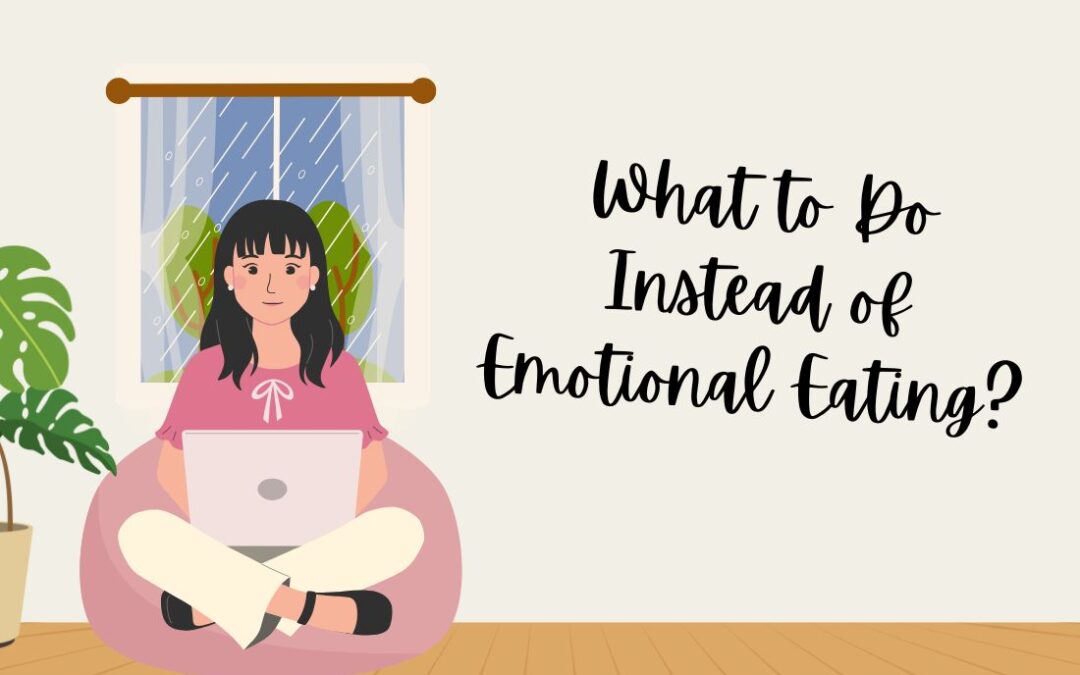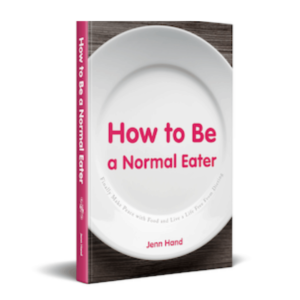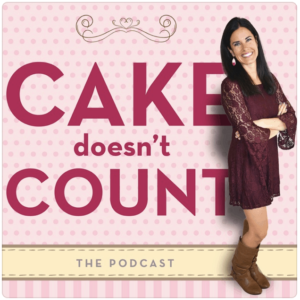If you’re wondering what to do instead of emotional eating, you’re likely looking for simple, practical strategies to manage your emotions in a healthier way.
And, if you’ve ever found yourself reaching for a snack when you’re stressed, sad, or bored, you’re not alone.
Emotional eating can be a tough habit to break, but the good news is there are better ways to cope with those feelings.
In this post, I’ll cover how to recognize emotional hunger and give you the tools you need to break the cycle and feel more in control—without feeling deprived.
Written by Jenn Hand, Holistic Nutritionist, Board Certified Health Coach, NBC-HWC
Table of Contents
- My Emotional Eating Story
- One Simple Thing You Can Do Instead of Emotional Eating
- What Is Emotional Eating?
- What Causes Emotional Eating?
- Emotional Hunger vs. Physical Hunger
- The Emotional Eating Cycle
- The Food-Feeling Connection
- How to Identify Your Emotional Eating Triggers
- 7 Ways to Build Stop Emotional Eating in Its Tracks
- The Role of Self-Compassion in Healing Emotional Eating
- Mindfulness Techniques for Managing Emotional Eating
- You CAN Break the Bonds of Emotional Eating
- Common Questions about Emotional Eating
My Emotional Eating Story
My “realization” that I emotionally ate was sort of a tidal wave of insight.
It wasn’t a moment of being stressed and realizing I ate ice cream to soothe myself. It was a torrent of understanding. I realized that my compulsion to use food to soothe pain, heal sadness, ease loneliness, deal with overwhelm, and numb out from struggle, hardship or any emotion I didn’t know how to deal with was something that I had done almost every day for 13 years.
The most poignant example of this playing out in real life was when I was in Thailand, teaching English post college.
There were so many emotions that time–uncertainty over what I wanted to ‘do with my life,’ anxiety about trying to live in a country where I didn’t speak the language, fear of what I would do when I moved back to the States, confusion over the man I was dating at the time, body image issues I was struggling with and more.
Yet, even amidst those challenges, I worked to feel the emotions rather than turn to food, and it was incredibly tough.
Overcoming emotional eating has been a journey of courage, self-compassion, and resilience, and it’s a path that continues to teach me about our ability to feel as human beings.
If you’d love to stop emotional eating and stress eating, keep reading to find out what to do instead!
One Simple Thing You Can Do Instead of Emotional Eating
The next time you feel the urge to eat emotionally, take a moment to pause and try this simple box breathing technique: breathe in slowly for four counts, hold for four, and exhale for four.
Repeat this for a few rounds.
This practice helps you ground yourself, calm your nervous system, and create space between the craving and your response. By taking just a minute to breathe, you can shift your focus away from food and give yourself the opportunity to check in with your emotions, helping you make a mindful choice.
One of the biggest things that helps with healing is creating the space in between our emotion and the automatic response to eating. This breathing technique will help create that space!
What Is Emotional Eating?
Emotional eating is turning to food to cope with feelings rather than eating to satisfy physical hunger.
It often happens when we’re feeling stressed, sad, overwhelmed, or even bored, using food as a temporary source of comfort or distraction.
What Causes Emotional Eating?
Emotional eating is often triggered by stress, sadness, loneliness, or boredom.
These feelings can lead us to seek comfort in food, especially sweet or high-carb options that momentarily boost mood but don’t resolve the emotions driving the behavior.
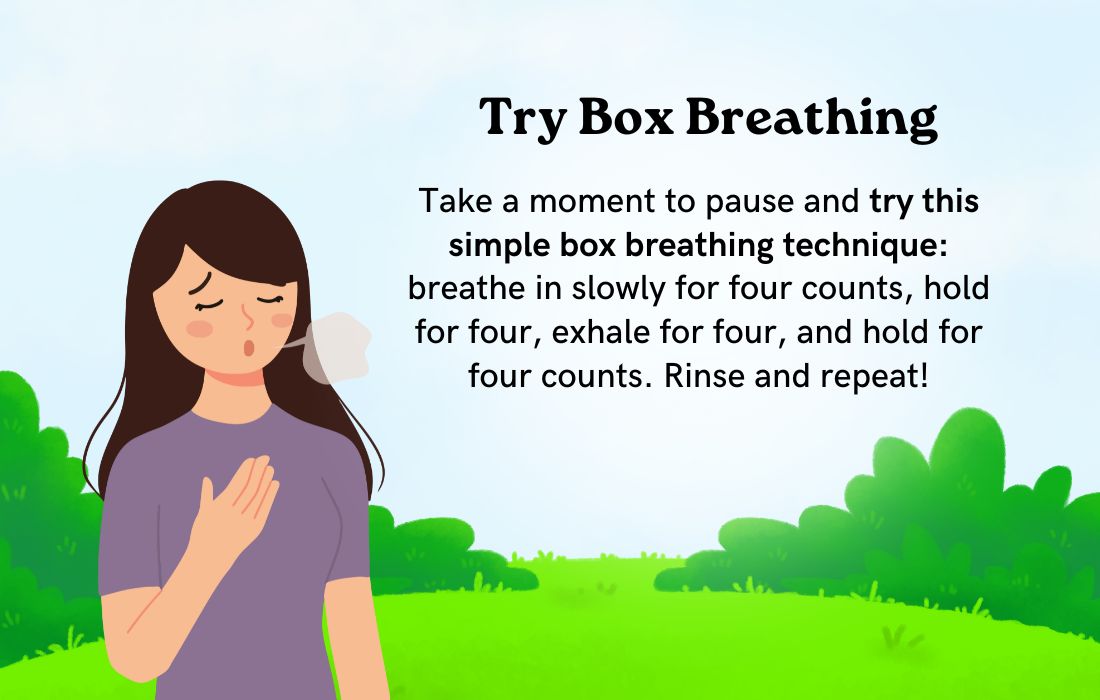
Emotional Hunger vs. Physical Hunger
Emotional hunger feels urgent, specific, and often tied to cravings for certain comfort foods.
In contrast, physical hunger builds gradually and can be satisfied with any nourishing food. Recognizing the difference is key to breaking the cycle of emotional eating.
The Emotional Eating Cycle
Emotional eating often follows a repetitive cycle: an emotional trigger leads to eating for comfort, which can result in guilt or frustration.
This creates more negative feelings, driving the cycle of emotional eating and potentially contributing to weight gain or health challenges.
The Food-Feeling Connection
Certain foods, like sweets or fried snacks, are closely tied to comfort and emotional relief.
While they may temporarily soothe emotions, they don’t address the underlying feelings that led to eating in the first place, leaving the root cause unresolved.
How to Identify Your Emotional Eating Triggers
Recognizing your triggers is a powerful step toward breaking free from emotional eating.
Pay attention to the moments or emotions that lead you to reach for food, whether it’s after a stressful day at work, during a tough conversation, or when you’re feeling bored or lonely.
Writing these patterns down can help bring clarity and awareness.
Is it a specific person? A certain situation? An email from someone? A time of day? Pay attention to where you get the “triggered” feeling to then begin to create a plan to use something other than food to help you through it!
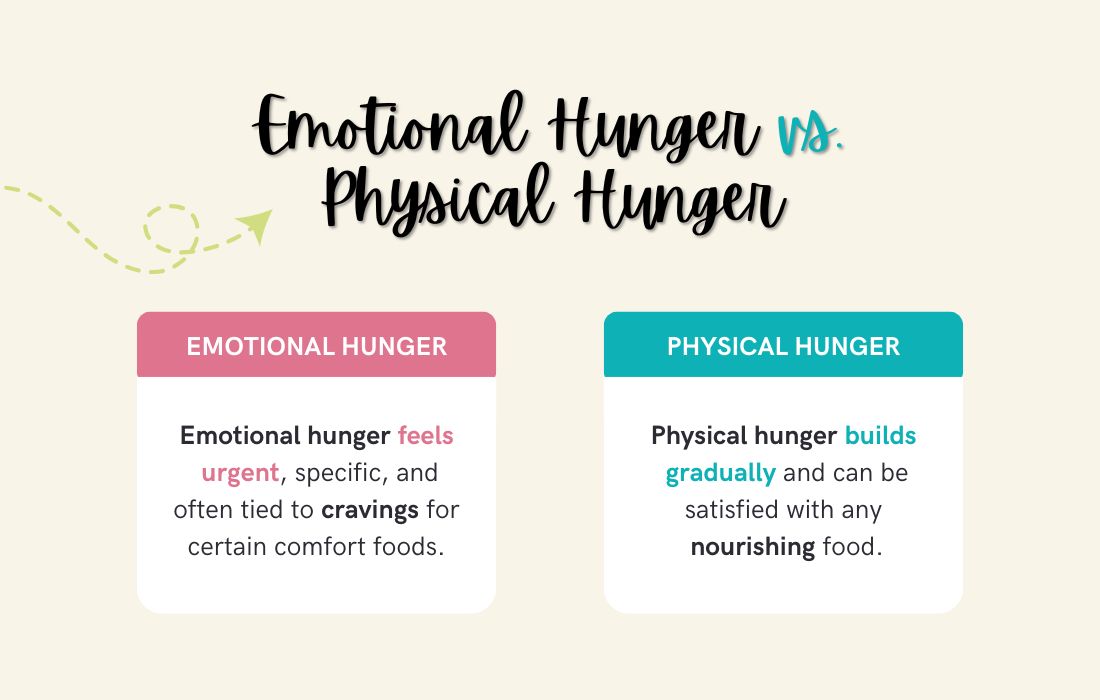
7 Ways to Build Stop Emotional Eating in Its Tracks
Overcoming emotional eating can feel frustrating.
And if you’re focusing on weight loss, you might start to feel desperate, wishing you could just be your “ideal” weight immediately. But it can take time, patience, and self-acceptance to deal with uncomfortable emotions without using food to cope.
Addressing emotional eating means addressing your emotions rather than pretending they aren’t there or pushing them down. The list below includes a few different coping skills that can help you deal with emotional eating triggers and prevent mindless eating.
1. Keep a Food Diary
Track what you eat alongside your emotions to uncover patterns between your feelings and eating habits. This isn’t about judging yourself but about gaining awareness to better understand your needs. You can use a food diary to keep track of your eating for a week or two.
2. Tame Your Stress
When it comes to managing stress through non-food methods, you might need a few different tools in your toolbox.
Try breathing exercises, yoga, journaling, deep breathing exercises, listening to calming music or taking a few minutes to step outside and reset when life feels overwhelming. Start small and focus on finding what works best for you.
3. Find Other Ways to Feed Your Feelings
Identify non-food ways to comfort yourself, like listening to music, journaling, or calling a friend.
Be kind to yourself as you experiment with new ways to handle tough emotions. It can take some time to learn how to deal with your feelings without food.
4. Pause When Cravings Hit and Check In With Yourself
When you feel an urge to eat, pause and ask, Am I hungry, or is this something else? It’s okay if this feels tricky at first—learning to listen to yourself takes time.
5. Snack on Nourishing Foods and Indulge Mindfully
Choose nutrient-dense options when you’re hungry, and when you indulge, focus on mindful eating—savoring each bite and stopping when satisfied. Remember, it’s okay to enjoy treats as part of a balanced approach.
6. Learn From Setbacks
Setbacks are part of the process–this path is not linear! Reflect on what happened, learn from it, and use that knowledge to navigate future challenges without judgment. Progress, not perfection, is what matters most.
7. Get Support While Building Healthy Habits
Emotional eating is tough to tackle alone. Seek support from a coach, therapist, or supportive community to help you build lasting, healthy habits. You don’t have to figure it all out on your own.
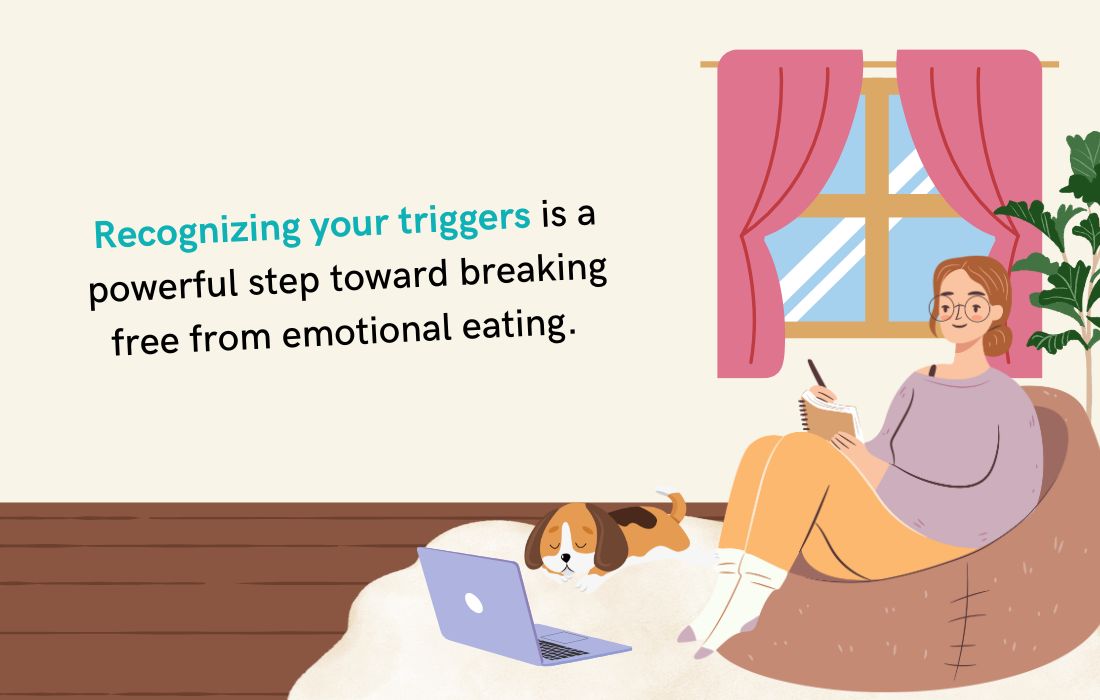
The Role of Self-Compassion in Healing Emotional Eating
Self-compassion plays a crucial role in healing from emotional eating.
Rather than criticizing yourself when you slip up, approach each moment with kindness and understanding. (My favorite motto? Pretty good is perfect!) Recognize that emotional eating is a human experience, and healing takes time.
By treating yourself with compassion, you create the space to learn, grow, and make healthier choices without guilt or shame.
Mindfulness Techniques for Managing Emotional Eating
Mindfulness can be a powerful tool for managing emotional eating.
One simple technique is box breathing: take a slow, deep breath in for four counts, hold for four, and exhale for four. This can help calm your nervous system and shift your focus away from the urge to eat.
Practicing mindfulness also helps you become more in tune with your body, allowing you to notice hunger and fullness cues and respond with awareness rather than automatic reactions.
You CAN Break the Bonds of Emotional Eating
Breaking free from emotional eating is possible, and it starts with small, consistent steps.
By building awareness of your emotional triggers, practicing self-compassion, and using mindful strategies, you can create new, healthier habits that support your emotional and physical well-being.
Remember, this is a journey, not a destination and there will be days of progress and days of frustration. You are learning how the art of how to deal with life without food!
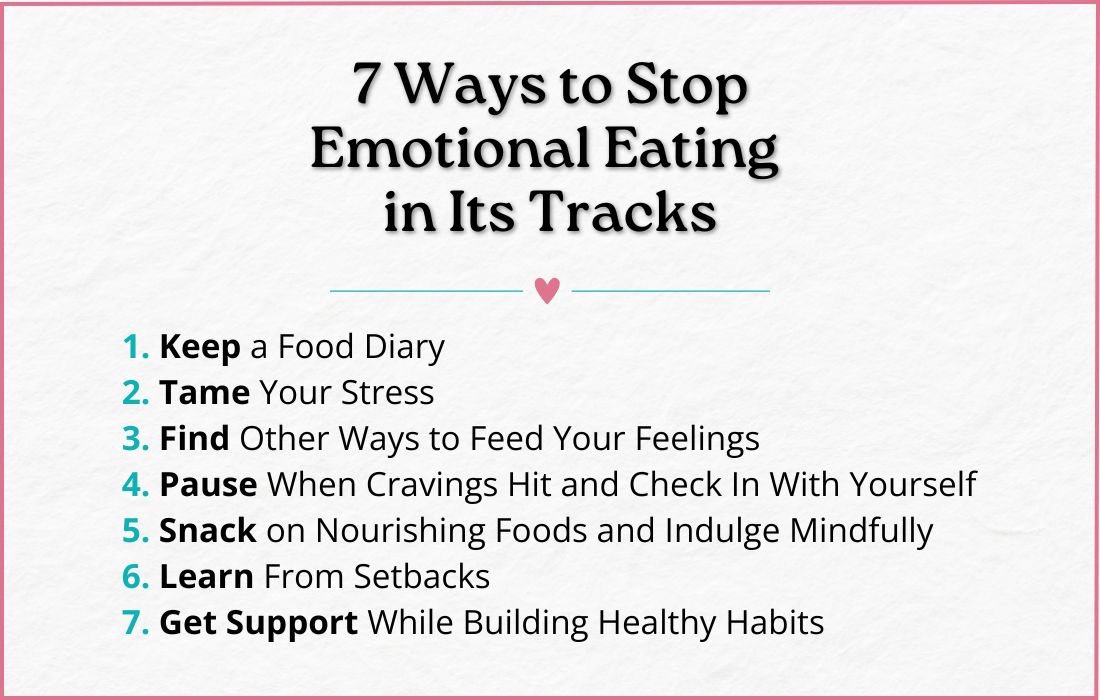
Common Questions about Emotional Eating
What is an alternative to emotional eating?
Alternatives to emotional eating include activities that help process emotions, like journaling, taking a walk, meditating, or talking to a friend.
How do you heal from emotional eating?
Healing from emotional eating involves understanding your triggers, building tools to cope with emotions, and practicing self-compassion as you create a healthier relationship with food and feelings.
How do you retrain emotional eating?
Retraining emotional eating means developing new habits, like pausing to identify your emotions before reaching for food and finding healthier ways to soothe or manage those feelings over time.
What can trigger emotional eating?
Common triggers include stress, boredom, loneliness, sadness, or even certain social situations. Recognizing these triggers is the first step in addressing them without food.
How do you break out of emotional eating?
Breaking the cycle starts with awareness and interrupting the pattern. Take a moment to breathe, check in with yourself, and choose a response that aligns with your emotional needs rather than eating.
How do you avoid emotional eating?
Avoiding emotional eating involves building a toolbox of coping mechanisms, staying aware of your hunger and fullness cues, and practicing mindfulness to handle emotions as they arise.
How do you stop overeating when feeling emotional?
Pause before eating to ask yourself what you really need. If you’re not physically hungry, try addressing the emotion directly—whether it’s by journaling, moving your body, or taking a self-care break.
Why do I feel anxiety after eating and how can I manage it?
Feeling anxiety after eating often comes from guilt or worries about food choices. To manage it, remind yourself that all foods fit, focus on how you’re nourishing your body overall, and practice self-kindness as you move forward.
Related Articles
⚪ What Is Emotional Eating?
⚪ How To Stop Boredom and Emotional Eating
⚪ How to Not “Give In” to Emotional Eating
Get the Normal Eater’s Newsletter
Join 8000+ women who are overcoming overeating, binge eating, and breaking up with dieting forever. Get Jenn’s inspiring and actionable weekly newsletter with the latest posts, podcasts, and tips on how to love your body, find food freedom, and lose weight holistically.
Get the Normal Eater’s NewsletterWork with an Emotional Eating & Holistic Nutrition Coach
Overcome Bingeing and Emotional Eating and Break Up with Yo-yo Dieting
Working with an emotional eating coach and holistic nutritionist can help you get free from the frustrating binge and restrict cycle and stop yo-yo dieting.
You don’t have to be obsessed with food or have a million rules around eating to find your natural weight and learn to love your body. Ready to actually see a lasting change and experience true freedom?
Schedule a 20-min CallAbout the Author:

Jenn Hand has been helping women like you become normal eaters since 2015.
She’s worked with thousands of women, helping them to balance their bodies, end bingeing, stop obsessing over food, and start feeling amazing again. As a board-certified health coach and holistic nutritionist, Jenn knows how to support you in making real positive changes that last.
Her articles have been published on Mind Body Green, Tiny Buddha, Thrive Global and other local and global media platforms. She’s the author of How to Be a Normal Eater and the creator of The Normal Eater’s Club program. Listen to Jenn’s advice and tips on the Cake Doesn’t Count Podcast, or read more of her articles for free on the Food Freedom Blog.
Learn About Coaching!
